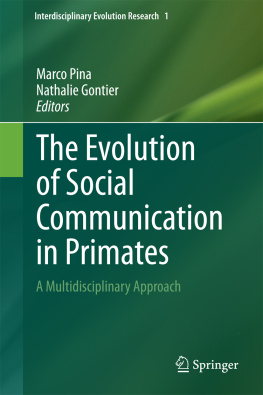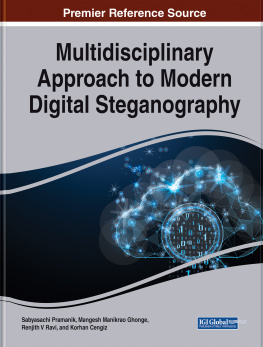Marco Pina and Nathalie Gontier (eds.) Interdisciplinary Evolution Research The Evolution of Social Communication in Primates 2014 A Multidisciplinary Approach 10.1007/978-3-319-02669-5_1
Springer International Publishing Switzerland 2014
Studying Social Communication in Primates: From Ethology and Comparative Zoology to Social Primatology, Evolutionary Psychology, and Evolutionary Linguistics
Nathalie Gontier 1 and Marco Pina 1
(1)
Applied Evolutionary Epistemology Lab, Centre for Philosophy of Science, Faculty of Science, University of Lisbon, Lisbon, Portugal
Abstract
Research fields adhere to particular epistemic frameworks that outline the methodological rules of conduct on how to study and interpret primate behavior as both social and communicative. Since the onset of social communication studies, epistemic focus has shifted from behaviorist observations to an examination of the cognitive and neurological capacities that underlie the observed communicative behavior and subsequently, toward an investigation of the evolutionary units, levels, and mechanisms whereby social communication evolved. This volume brings together scholars from within these diverse fields who (1) investigate the historical and epistemic roots of the primate communication/human language divide; (2) identify and analyze the building blocks of social communication; (3) examine how primate social communication strategies are evolutionary precursors of human language; and (4) analyze how social communication differs from human language. In their chapters, the contributors explain the merits and pitfalls of their field-specific epistemic approaches. They compare them to other theoretical frameworks and they give guidelines on how theory formation on the origin and evolution of social communication in primates can be enhanced by allowing for epistemic plurality.
Emotions, expressions, vocal signaling, and manual and bodily gestures are evolved means whereby primates, including humans, communicate socially. Additionally, humans have invented signed and vocal languages that not only enable social communication but also abstract, symbolic, and creative thought on the past, present, future, and the inexistent. The development and evolution of social communication in humans and other primates has been studied from within multiple disciplines, ranging from ethology and comparative zoology, over primatology and comparative psychology, to evolutionary psychology and evolutionary linguistics. In this volume, contributors examine the epistemic frameworks of these various fields and they give directions for future research.
Introduction to the Theme and Outline of the Book
The study of human language is preceded by a rich history reaching back as far as the early Greek philosophers works. Early philosophers understood language primarily as a knowledge device that enables the expression of abstract thought. The study of social, non-verbal, and verbal communicative behavior in other primate species, and the recognition that human language too can be investigated as a communicative behavior, originated much later in time. From the seventeenth century onward, utopian thinkers and social contract philosophers considered human languages a communicative means to bond societies both socially and politically (see Gontier for an overview). These ideas were foundational for nineteenth century natural history scholars, and rising fields such as historical linguistics and biology provided the first historical and evolutionary accounts on the origins of verbal and non-verbal communication in our and other species. This history results in the fact that scholars today continue to distinguish human language from other forms of animal and primate communication.
This volume brings together scholars from within diverse fields who:
(1)
Investigate the historical and epistemic roots of the primate communication/human language divide;
(2)
Identify and analyze the building blocks of social communication in primates;
(3)
Examine how primate social communication strategies can be understood as evolutionary precursors of human language; and
(4)
Evaluate how social communication differs from human language.
We make no attempt to provide a complete account on the various data and theories that exist on the origin and evolution of social communication in primates and the origin of language in humans. Indeed, such cannot be the subject of one book alone. With this anthology, we do hope to provide an introductory review of some of the main methodological and theoretical frameworks that are currently available to investigate the origin of both social communication and human language.
Today, due to the nature of academia and how disciplines are structured, beginning scholars often have to make crucial and limited choices on the types of methodologies they will apply and the kind of theoretical frameworks they work from. This has resulted in numerous high-standard and specialized volumes that investigate the subject of this book from within one specific school or theoretical framework. Results of this research are then presented at excellent high-profile conferences such as Evolang; Language, Culture, and Mind; Ways to Protolanguage; or at annual meetings of the International Primatological Society; the International Society of Zoological Studies; the American Association of Physical Anthropologists; the Animal Behavior Society; the Human Behavior and Evolution Society; the International Cognitive Linguistics Society; the European Society for Philosophy and Psychology; and so on. Nonetheless, these conferences and their proceedings or journals are targeted at field-specific audiences that work within certain but not other disciplines. The unfortunate result is that the scientific outputs often remain juxtaposed.
In this anthology, we have invited our writers to provide reviews of how the research programs that underlie their specific fields define studies on primate communication and human language. The contributors give an overview of the gathered data, they explain the methodologies used to collect them, and they demonstrate how such data contributes to overall theory formation on the subjects at hand. Rather than present new data, the authors thus highlight the numerous methodologies and epistemic frameworks that are currently at a researchers disposal. This book does not select a winning methodology or research school. The aim of this volume is to provide the reader with ways to break into the research, by showing how rich and informed research on the origin of social communication and human language can be when we allow for epistemic plurality. How the results of these various lines of research can be combined into broader, more encompassing theories on the origin of social communication and language goes beyond the scope of this volume.
Brief Sketch of the Various Epistemic Frameworks Available for Researching Social Communication and Language in Primates
What are the epistemic frameworks that guide researchers in their studies on primate communication and human language? Current research methodologies and theoretical frameworks on communication and language originated around the turn of the last century, when they emancipated from classic philosophical traditions.
The field of ethology arose in the 1930s, mostly in Europe, as an outgrowth of both naturalized epistemology and comparative zoology. Inspired by early scholars such as von Uexkll (). These scholars contributed by defining how we can observe animal behavior and how we can conduct both comparative developmental and evolutionary research on animal behavior, including communication.










